
|
Japanese External Reverse Porro Prism Binoculars. WEBSITE MUSEUM |
|
OTHER BINOCULARS #1 & OPTICAL SIGHTS (MOSTLY MILITARY) |
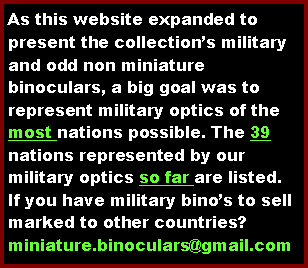
|
TWO Nedinsco (Dutch Zeiss) 7x50 M/56 Danish Navy Binoculars serial number 4797 and serial number 4581 |
|
The Nederlandse Instrumenten Compagnie (usually known as Nedinsco) is a Dutch subsidiary of Zeiss that was founded in 1921 in Vlissingen in the Netherlands, then soon moved to Venlo. I assume it was founded to be able to produce military optics without regard to restrictions against German military production imposed by the WWI Treaty of Versailles. These two M56 Nedinsco binoculars carry a Crown military property mark, dessicant ports, believed for a Danish Navy contract. |
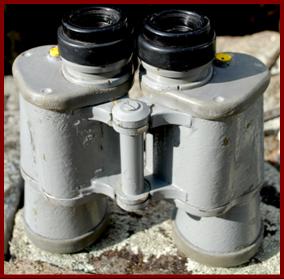
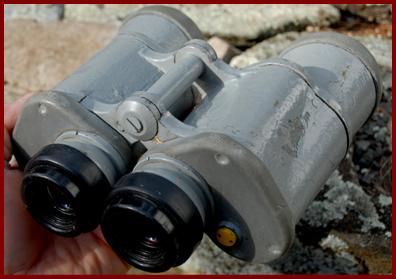



|
S Ǿ ARTILLERIET (NAVAL ARTILLERY) |
|
MARINE-TJENESTEKIKKERT (MARINE SERVICES/ NAVY) |
|
M/56 (believed to indicate MODEL 1956) |
|
British Barr & Stroud Ltd Type G.K.5 6x42 Naval Artillery Director Binoculars |
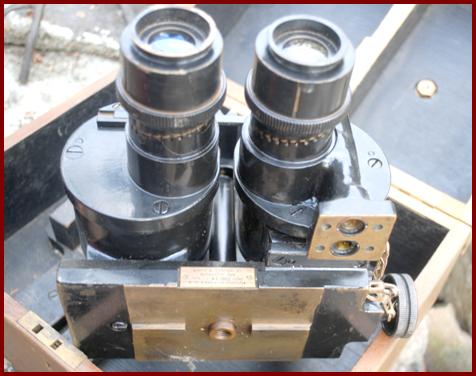
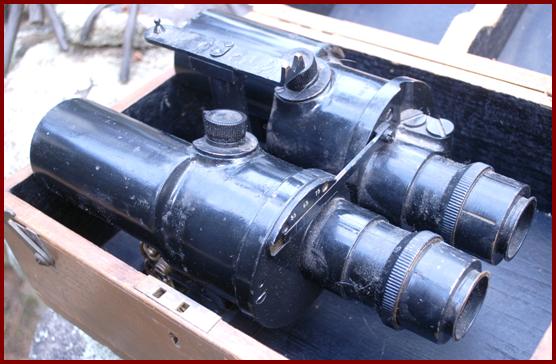
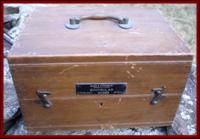
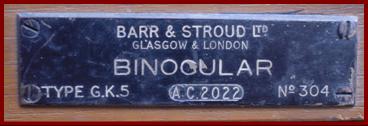
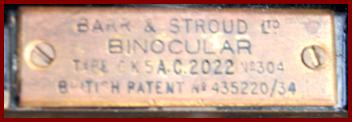
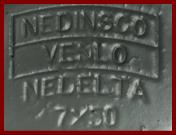
|
My British Royal Navy G.K.5 Fire Director binoculars were made by the Scottish Firm of Barr & Stroud Ltd Glasgow. Fire directors calculate the arc of fire (indirect fire) necessary to drop artillery rounds on targets over much longer distances than possible for direct fire (think mortar versus rifle sighting). This is the optical line of sight mechanism which would interact with the distance calculation and gun performance factors and wind factors when attached to the fire director to give elevation and windage settings to the gun crew. Undated, but believed to date in the period WWII to a decade or so after WWII. |
|
These binoculars serial # 4797 have rubber ocular and objective ring protection and rubber top body protection, as had been common on German WWII binoculars intended for naval use. Were repainted gray. |
|
Ross 7x50 Naval Artillery Director Military Binoculars Pattern G-352 |
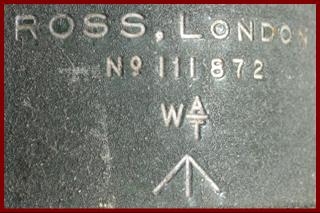
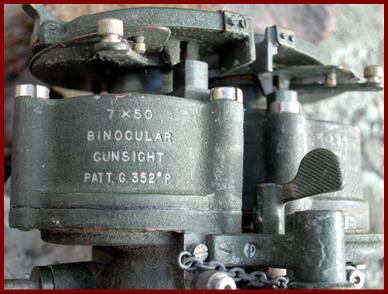
|
My British Royal Navy pattern G-352 7x50 Fire Director Binoculars were made by the British firm Ross London. They would originally have has a rubber brow pad and eyecup. Fire directors calculate the arc of fire (indirect fire) necessary to drop artillery rounds on targets over much longer distances than possible for direct fire (think mortar versus rifle sighting). This is the optical line of sight mechanism which would interact with the distance calculation and gun performance factors and wind factors when mounted to the DCT (Director Control Tower) fire director to give elevation and windage settings to the gun crew. This particular model of Ross binoculars was illuminated, and has filters of different colors on a rotating disc. And like many Naval optics, these binoculars have desiccant ports with caps. The distance between eyepieces can be adjusted. |
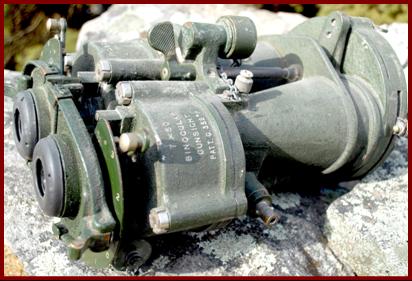
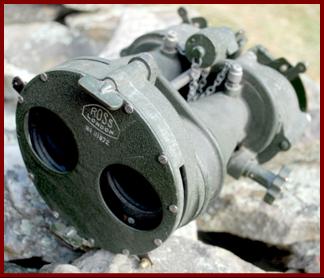
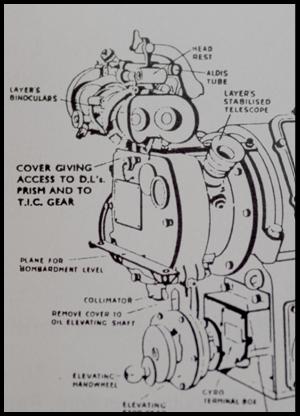
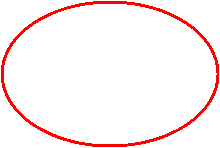
|
A similar model of Ross Artillery Director Binoculars are shown below mounted to a Navy Director Control Tower for surface targets (there were also fire directors for anti aircraft guns). |
|
The “Broad Arrow” mark is a UK Ministry of Defense Property mark. The “ W ” usually means waterproofed on British Optics. |
|
1944 blc Zeiss 7x50 German Gas Mask Military Binoculars |
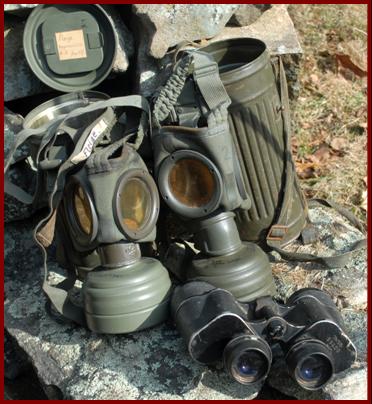
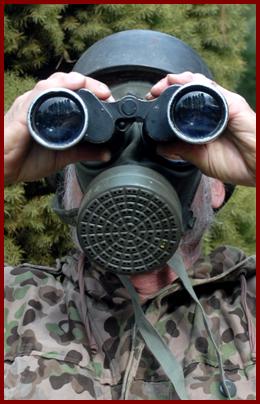
|
My uncommon version blc (German WWII mfgr code for Zeiss) binoculars were specifically designed to be able to be used when wearing a gas mask, having large ocular lenses & long eye relief. They are pictured at left with an early 1936 dated Wehrmacht short gas mask and short can, and a later WWII German military long gas mask and can. By the serial number and also by not having a range grid reticle, these binoculars are believed to have been made in 1944. All were probably WWII US soldier bring back “souvenirs”. The 1936 gas mask on the left and it’s can are both marked to Mr. Fleige, who was a WWII shunt manager at the Freiburg Hauptbahnhof railway station (Brg.Hbf), the main train station of Freiburg im Breisgau, in Baden-W ü rtenburg. |
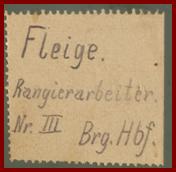
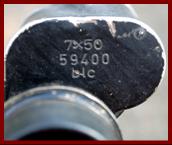
|
1939 Huet 7x50 French Armee de L’Air (Air Force) Military Binoculars |
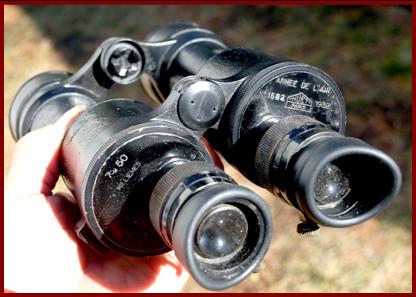
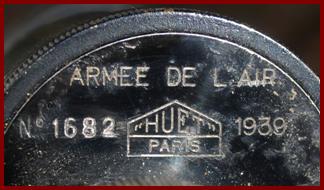

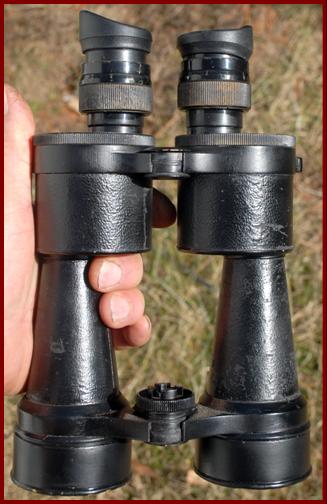
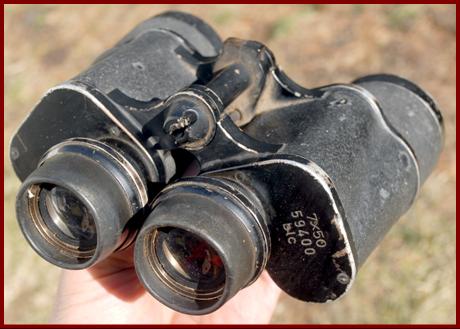
|
My 1939 dated French Huet Paris 7x50 binoculars are marked as being property of the Armee de L’Air , the French Air Force. Huet brand binoculars were made by the firm Soc ié t é G é n é rale d’Optique” (SGO), which made many of the French government and military binoculars, and also civilian binoculars. When the German army occupied France, many French Huet military binoculars were seized and used, plus the Huet company continued to manufacture these type binoculars for Germany, but with the occupation produced binoculars marked Huet “dienstglas” or Huet Kreigsmarine: see my three at OTHER BINOCULARS #12 . |
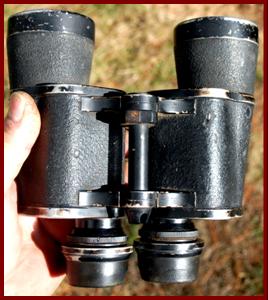
|
1939 Huet 16x50 French Armee de L’Air (Air Force) Military Binoculars |
|
My 1939 dated French Huet Paris 16x50 binoculars are marked as property of the Armee de L’Air , the French Air Force. This marking had been painted over. It is common when a soldier “liberated” government owned binoculars for the property mark to be defaced or covered up. But a certain amount of French military equipment including binoculars were reused by occupying German troops, so it is also possible a Wehrmacht army user simply painted over the air force mark. Huet brand binoculars were made by the French company Soc ié t é G é n é rale d’Optique” (SGO) . |
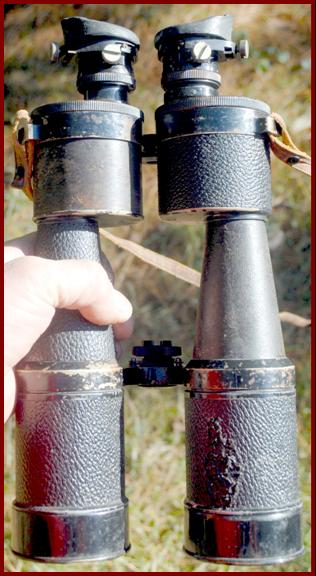
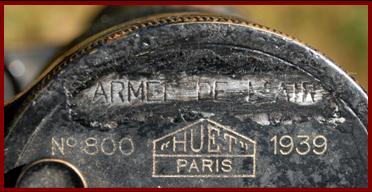
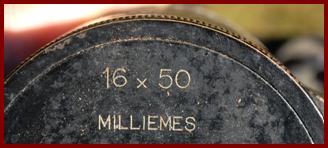
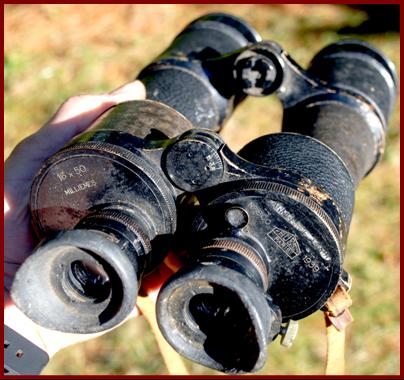
|
These 16x military binoculars are a unusually high magnification for hand held military (and civilian) binoculars |
|
Huet 10x50 French Marine Nationale Navy Modele 1933 Type 1 Military Binoculars |
|
My model 1933 type 1 French Huet Paris 10x50 binoculars and case are marked as property of the Marine Nationale (French Navy), and of being part of a Navy contract. These binoculars are believed dated between 1933 and 1940, and were made by the French co. Soc ié t é G é n é rale d’Optique” (SGO). A certain amount of French military equipment including these type binoculars were reused by occupying German troops, and under occupation these were for the German military, but with occupation binoculars normally marked “dienstglas” for the German and Kreigsmarine for German navy use, as below |
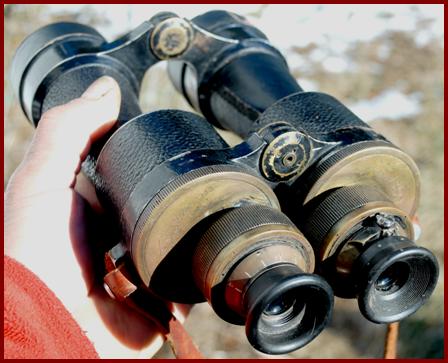
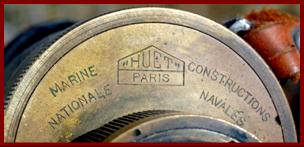
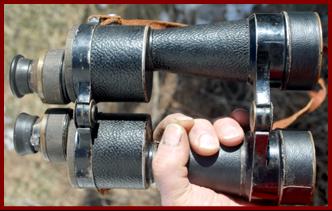
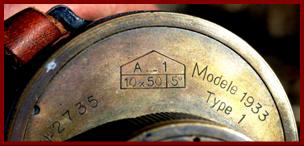
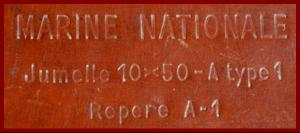

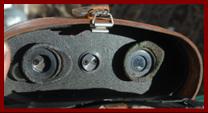
|
Filter eye cups |





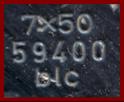
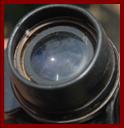
|
ARGENTINA AUSTRIA AUSTRALIA BELGIUM BRAZIL BULGARIA CANADA CHINA CZECHOSLOVAKIA DENMARK EAST GERMANY FINLAND FRANCE GERMANY |
|
HUNGARY INDIA IRAQ IRAN ISRAEL ITALY JAPAN LUXEMBOURG NETHERLANDS NORTH KOREA NORTH VIETNAM PERSIA POLAND ROMANIA |
|
RUSSIA SLOVAK REPUBLIC SOUTH AFRICA SPAIN SWEDEN SWITZERLAND TURKEY UNITED KINGDOM USA WEST GERMANY YUGOSLAVIA
|

|
NON MINIATURE BINOCULARS & OPTICS: MOSTLY MILITARY |
|
On-line sellers of 1933 and 1939 pattern Huet military often claimGerman use. Captured stock were used by the Germans but German use is pure speculation and when capture reused their was no correlation between French Navy, Air Force, or Army use models and German branch of service use. |
|
Huet DF 12x50 A’m1d Artl. French occupation German Kriegsmarine marked binoculars #2509 |
|
WWII Made in Occupied France Huet 8x30 Krieigsmarine marked German Navy military binoculars |
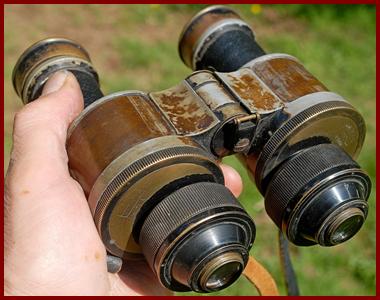

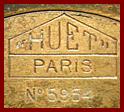
|
The French Societ é Generale d’Optique, maker of Huet optical goods, made my DF 8x30 Artillery binoculars serial number 5854 for the Kriegsmarine/ German Navy |
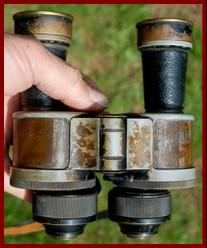
|
Huet production of their existing French military optics designs such were continued for the German military during the German occupation of France June 1940-1944, with some German markings, as with mine. Captured existing Huet optics were also used by the German military, but these usually only had their original French markings. My occupation binoculars have a right ocular graticule/ strichtplatte grid. |
|
TWO (2) WWII German Occupied France Made Huet Dienstglas 7x50 German Army binoculars, serial number 153, and also serial number 501 |
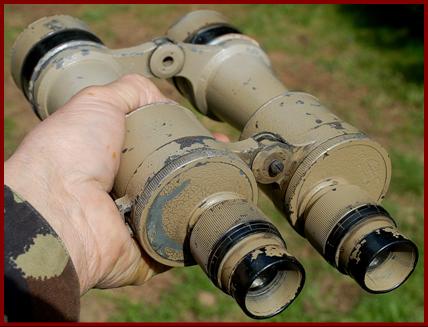
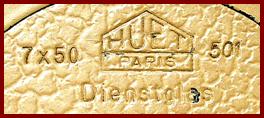
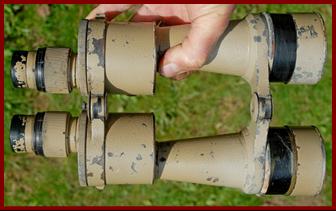
|
Serial # 501 |
|
My two Huet Paris 7x50 binoculars serial # 153 and 501with strikplatte/ graticule and sliding ojective shields were made by the Societ é Generale d’Optique in France under German Occupation (June 1940 to 1944), and based on the common late war tan paint (nothing to do with DAK despite nonsense internet claims of tan binoculars being DAK). I believe these to be a late war production model, based on Huet pre war designs. I have also seen identical Huet Dienstglas 7x50 binoculars with serial #455, #479, and #536, and with mine that suggests a quite small production run. |
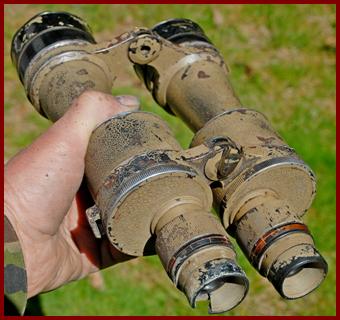
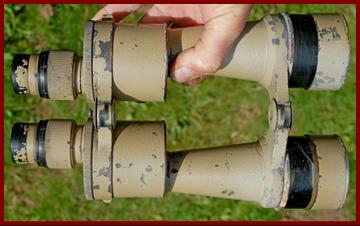
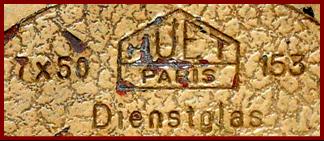

|
Case is marked to Col D,V. Swanson. I could find no US colonel D.V. Swanson, or any US military ID 0240321. So may be a British or Canadian capture? |
|
Serial # 153 |
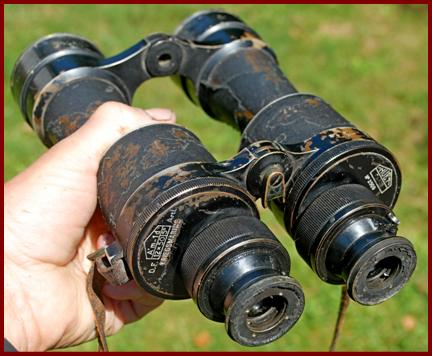
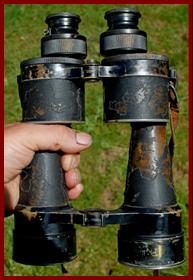
|
The French Societ é Generale d’Optique, maker of Huet optical goods, made my DF 8x30 Artillery binoculars serial number 2509 for the Kriegsmarine/ German Navy, during the occupation of France. |

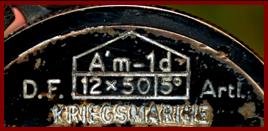
|
As was quite common, the Australian soldier who brought these home blacked out the German marking. |
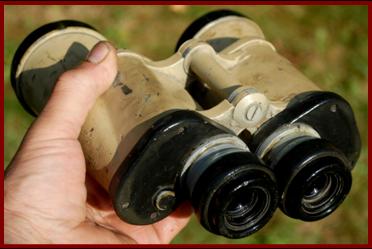
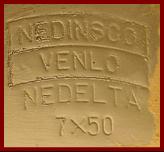
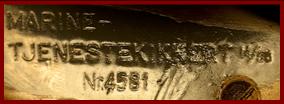
|
M/56 (believed to indicate MODEL 1956) |

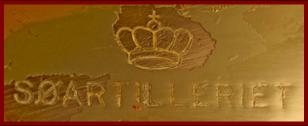
|
MARINE-TJENESTEKIKKERT (MARINE SERVICES/ NAVY). Binoculars serial # 4581 were repainted gray then repainted sand. |
|
S Ǿ ARTILLERIET is (NAVAL ARTILLERY) |
|
Zeiss Nedinsco D.v.D ( Departement van Defensie) Dutch Army 6x24 military binoculars made in the Zeiss licensed Nedinsco Venlo Netherlands factory, serial number 1503170 |
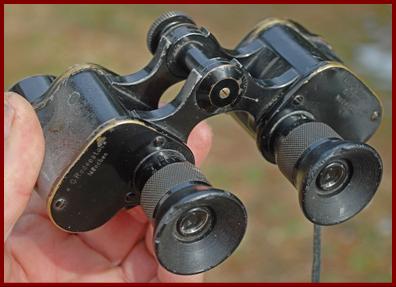
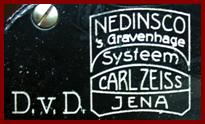
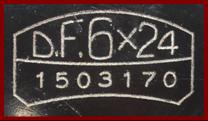
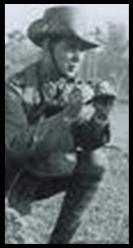
|
My Nederlandse Instrumenten Compagnie Zeiss Nedinsco D.v.D binoculars are marked ( Departement van Defensie, or Department of Defence, which existed 1928-1941) DF (Doppel Fernrohrglas) These 6x24 binoculars were made in the 1930’s at the Zeiss licensed subsidiary Netherlands factory, which had been located in Venlo. These were issued to troops of the Dutch army. |
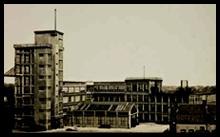
|
Nedinsco factory Venlo |
|
I believe my Nedinso binoculars were produced around 193—1931 (speculative). |
|
Huet Notorix modele 1928 type 1931 8x30 Marine Nationale / French Navy, serial number 2618 |
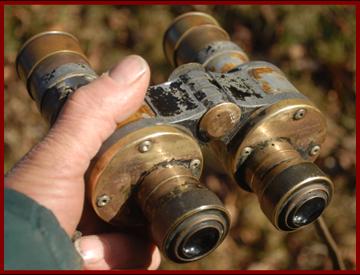
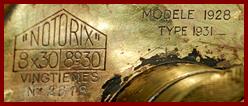

|
My Huet Notorix 8x30 Marine Nationale (French Navy) modele 28 type 1931 (revision) constructions navals (naval model) binoculars have lost most of their original black paint, and show hard use. While it is hard to tell, many or most of the pre 1940 French naval and air force binoculars of the types above were captured and reused by German forces, as well as some models being made for the German army under occupation and so marked. These are marked “demontag formellement nterdict” (disassembly is forbidden) and “tenir la jumelles bien seche” (keep the binoculars very dry). |
|
1940 BBT Krauss 12x50 French Armee de L’Air (Air Force) Military Binoculars serial #1175 |

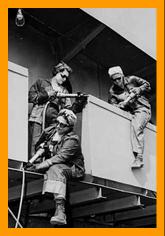
|
The French optical firm BBT Krauss was formed by the 1935 merger of the optical firm Societe des Establissements Krauss with Barbier, Bernard, et Turenne (BBT). |
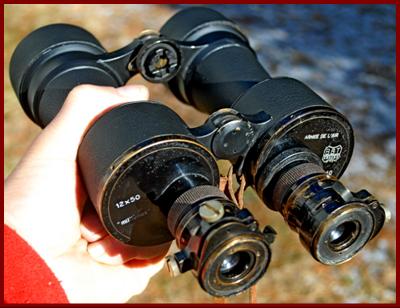
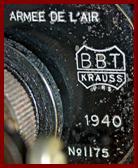
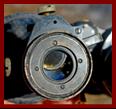
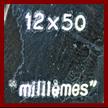
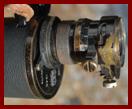
|
My 1940 12x50 BBT Krauss Armee de L’Air French Air Force binoculars serial # 1175 with right ocular graticule/ ranging grid also has a built in swing in place yellow ocular filters and a graticule leveling lever. |
|
NEWLY ADDED ITEMS ARE INSERTED MONTHLY THROUGHOUT THESE SECTIONS AND NOT NECESSARILY ON THE LAST PAGE. Redirected search such as google image may display old content or distortion: try a refresh and or go directly to the site : http//www.miniaturebinoculars.com |
![Text Box: CLICK ON PAGE LINE. CLIQUEZ SUR LA LIGNE DE PAGE. KLICKEN SIE AUF SEITENZEILE. HAGA CLIC EN LÍNEA DE PÁGINA..[ページ行]をクリックします。НАЖМИТЕ НА СТРОКУ СТРАНИЦЫ. ALSO SEE INDEX.](image851.gif)